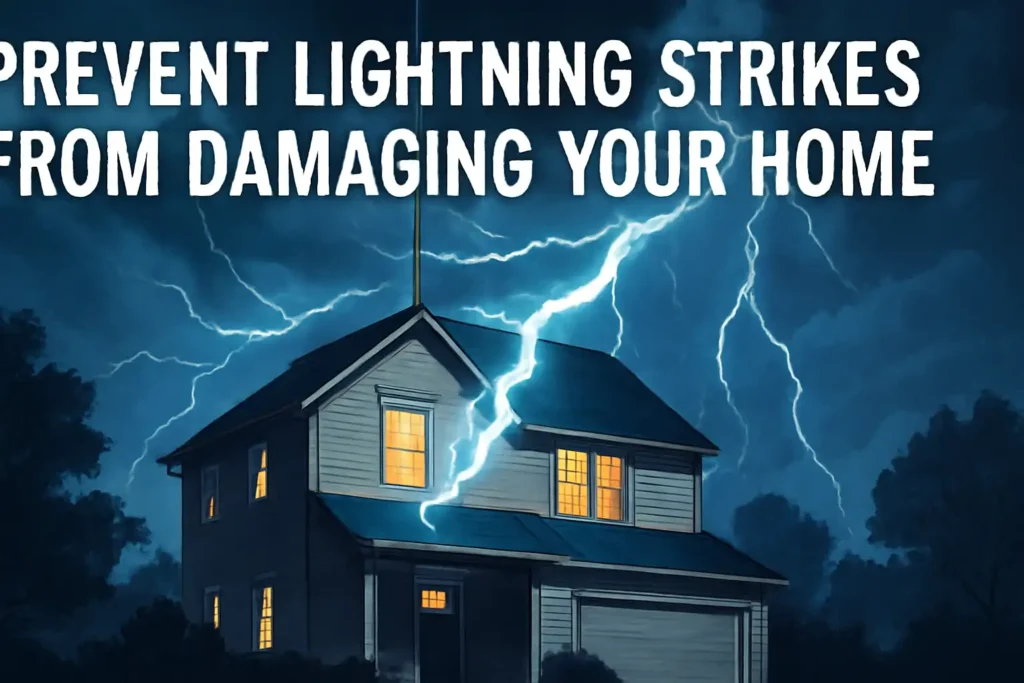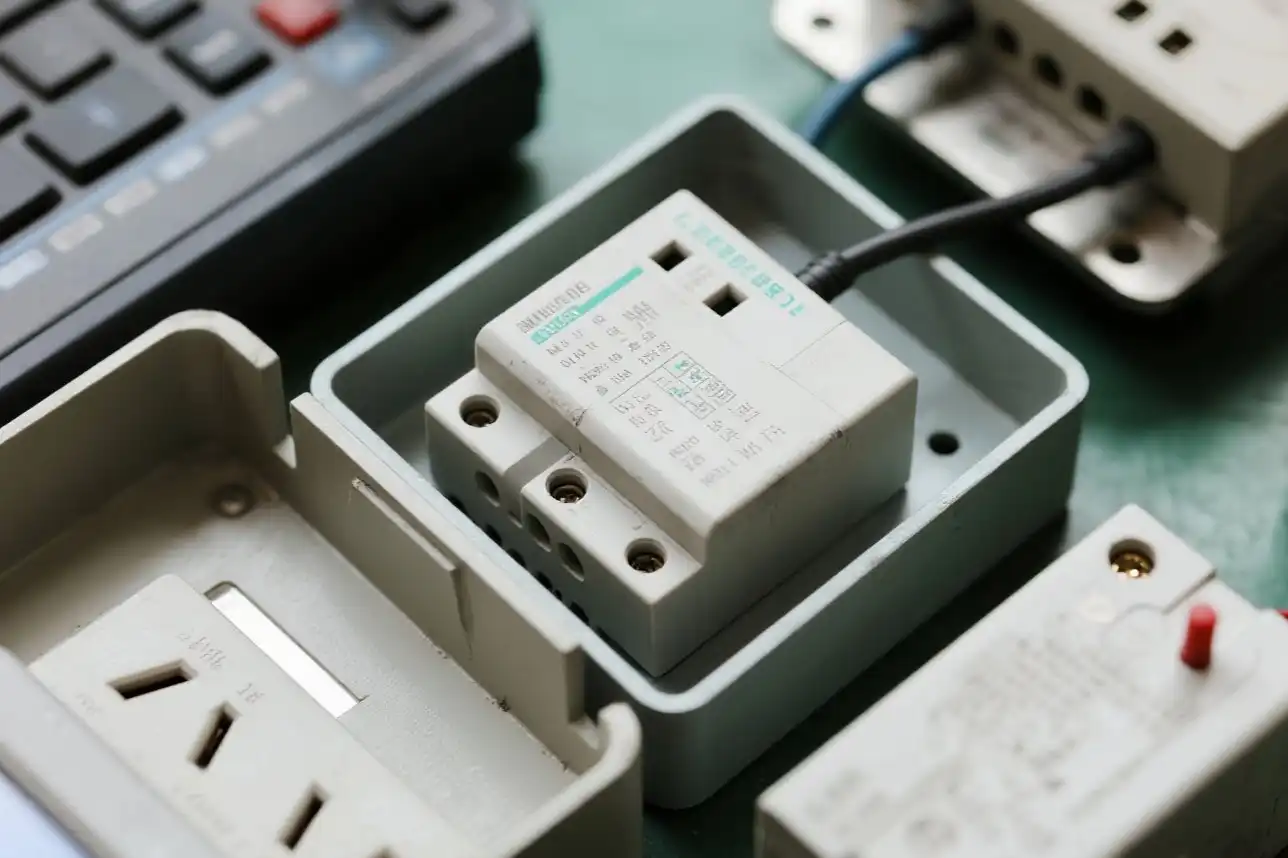You need special devices to help prevent lightning strikes from hurting your home. Lightning rods, grounding systems, surge protection devices, and shield wires all play a role. These systems do not stop lightning from hitting your house but instead move the electricity safely away from where you live. About 1 in 200 homes in the U.S. suffer lightning damage each year. Homes on hills, in open areas, or near water are at higher risk. Many new homes in storm-prone areas now use these devices to prevent lightning strikes and lower the risk.
Key Takeaways
- Use a full lightning protection system. This includes lightning rods, grounding, surge protectors, and shield wires. These devices help keep your home safe.
- Lightning rods move lightning safely to the ground. They lower the risk of fire and damage. But they do not stop lightning from hitting your home.
- Grounding systems send lightning electricity deep into the earth. This helps protect your home’s wiring and structure.
- Surge protectors keep your electronics safe from power surges. They work best with other lightning protection devices.
- Always hire certified professionals for installation and inspection. They should check your lightning protection system often for the best safety.
Prevent Lightning Strikes: Main Devices

If you want to prevent lightning strikes from hurting your home, you need some important devices. Each one does a different job. When used together, they help keep your house and family safer during storms. Here are the main devices you should know:
Lightning Rods
Lightning rods go on the highest parts of your home. These metal rods attract lightning and give it a safe way to reach the ground. When lightning hits, the rod grabs the strike and sends the electricity down thick wires called conductors. This stops lightning from going through your roof or walls, which could cause fires or big damage.
Tip: Lightning rods do not stop lightning from hitting your home. They just make sure the energy goes safely away from places where it can hurt you.
A good lightning rod system can lower the chance of fire and damage. Homes with certified lightning protection systems have up to 62% fewer fire claims. Fire risks drop by 93% when lightning current uses metal paths instead of things that can burn.
Grounding Systems
Grounding systems work with lightning rods to help prevent lightning strikes from causing harm. These systems use metal rods buried deep in the ground. When lightning travels down the rod and through the conductor, the grounding system sends the electricity safely into the earth. This keeps the energy away from your home’s wires and structure.
- Most building codes need at least two 8-foot copper-coated steel ground rods, spaced at least 6 feet apart.
- The rods must connect with thick copper or aluminum wires to make a strong, low-resistance path.
- Good grounding can absorb up to 98% of surge power before it gets to your appliances.
You should have a professional check your grounding system often. Rust or loose wires can make the system weaker.
Surge Protection Devices
Surge protection devices help prevent lightning strikes from hurting your electronics and appliances. When lightning causes a power surge, these devices act quickly. They send extra voltage away from your home’s electrical system and into the ground.
There are two main types:
- Whole-home surge protectors: These go at your main electrical panel. They protect all the wiring and big appliances in your house.
- Point-of-use surge protectors: These plug into wall outlets. You use them for computers, TVs, and other sensitive electronics.
| Device Type | Where It Protects | What It Does |
|---|---|---|
| Whole-home surge protector | Main electrical panel | Shields all circuits and large appliances |
| Point-of-use surge protector | Individual outlets | Protects sensitive electronics from voltage spikes |
Surge protectors do not stop lightning from hitting, but they help prevent fires and equipment damage by blocking dangerous surges.
Shield Wires and Masts
Shield wires and masts give even more protection. You often see these on bigger homes or buildings in open places. Shield wires stretch above the roof, while masts stand tall near the house. Both act as targets for lightning, guiding the strike safely to the ground through conductors.
- Shield wires and masts catch lightning before it can hit your roof.
- They connect to grounding systems, so the energy moves away from your home.
- These devices work best when put in by professionals who follow strict safety rules.
Note: No device can give total protection. But using lightning rods, grounding systems, surge protectors, and shield wires together can prevent lightning strikes from causing big damage.
By adding these devices, you take important steps to prevent lightning strikes from hurting your home. You also lower your risk of fire, electrical damage, and expensive repairs.
How Lightning Protection Works
Directing Lightning Safely
A lightning protection system gives lightning a safe way to reach the ground. When lightning hits your house, the system moves the energy away from places that could get hurt. You need several parts to make this work as a team:
| Component/Principle | Role in Lightning Protection |
|---|---|
| Lightning Rods (Air Terminals) | Catch lightning at the top and give it a place to strike. |
| Down Conductors | Carry the lightning safely down, using more than one path to lower the current. |
| Grounding System | Makes a low resistance path so lightning can go into the earth quickly. |
| Equipotential Bonding | Removes voltage differences, so you have less shock risk and fewer equipment problems. |
| Grounding Components | Uses ground rods, ring wires, radials, plates, and rebar to help grounding work well. |
Lightning rods sit on top of your house and pull lightning in. Down conductors take the electricity down the side of your house. The grounding system then pushes the energy deep into the ground. This setup helps stop fires or electrical damage from lightning strikes.
Role of Bonding
Bonding links all the metal parts in your house to the lightning protection system. You must bond things like HVAC units, plumbing, and electric panels. If you skip bonding, lightning might jump between metal parts and cause side flashes. Side flashes can start fires or break your electronics.
- Good bonding removes voltage differences between metal things.
- It keeps lightning from making its own path through your house.
- You lower the chance of shock and equipment problems.
Tip: Always check that every metal part is bonded to the system. This step is a key way to stop hidden damage from lightning strikes.
Importance of Professional Installation
You should always hire a trained installer for your lightning protection system. Professionals know how to plan the system for your home’s size and shape. They use the right materials and follow safety rules. A good installer checks that all parts connect well and that the grounding system has low resistance.
- Professionals test the system to make sure it works for a long time.
- They avoid mistakes, like missing a metal part or using the wrong wire.
- You feel safe knowing your system will protect your home when you need it.
Note: A well-installed system lasts many years and keeps working after lots of storms.
Surge Protection and Its Limits
Whole-Home Surge Protectors
Whole-home surge protectors go in your main electrical panel. These devices are the first defense against big power surges. They help protect your home’s wiring and large appliances from voltage spikes. Spikes can come from the utility grid or far-away lightning. Most surges in your house start outside or when big appliances turn on or off.
- Whole-home surge protectors handle normal surges, not direct lightning strikes.
- They lower extra voltage, but about 15% of a huge surge can still get in.
- Using other protection, like point-of-use surge protectors, helps even more.
| Limitation Aspect | Explanation |
|---|---|
| Designed for Typical Surges | Whole-home surge protectors work for surges from the grid or far-off lightning, not direct hits. |
| Limited Protection | They may lower some surge voltage but can break if lightning hits directly. |
| Need for Complementary Systems | You need lightning rods and grounding systems for full safety. |
| Physical and Wiring Damage | Direct strikes can still hurt your home’s structure and wiring. |
Point-of-Use Surge Protectors
Point-of-use surge protectors plug into wall outlets. You use them to protect things like computers, smart TVs, and game consoles. These devices catch leftover surges that whole-home protectors miss.
- Point-of-use protectors work well for small surges and power changes inside your house.
- They give extra protection for your most important devices.
- You should get new ones every 3-5 years to keep them working.
Tip: Using both whole-home and point-of-use surge protectors gives your electronics better protection.
What Surge Protectors Can’t Do
No surge protector can stop the huge energy from a direct lightning strike. Regular surge protectors only help with surges from nearby lightning or power line problems.
- Direct lightning strikes can reach up to one billion volts, which is too much for any surge protector.
- Surge protectors cannot stop fires, damage to your house, or wiring problems from a direct strike.
- You need a full lightning protection system—lightning rods, down conductors, bonding, and grounding—to handle direct strikes safely.
Note: Surge protectors are helpful, but they work best when you use them with a full lightning protection plan for your home.
Myths and Mistakes
Common Misconceptions
Many people think wrong things about lightning protection. These mistakes can make your home less safe. Here are some common myths:
- Lightning protection is only needed in stormy areas.
Lightning can hit anywhere, not just stormy places. You need protection no matter where you live. Even places with few storms can have lightning that hurts electronics. - Lightning protection costs too much and is hard to install.
There are options that do not cost a lot. Professionals can put them in easily. Fixing fire or broken electronics costs more than protection. - Lightning protection gives 100% safety.
No device can stop all lightning damage. These systems lower your risk but cannot promise total safety. Lightning is very strong, so you must still be careful during storms. - Only big buildings need lightning protection.
Any building can get hit by lightning. Small homes need protection too. Your house has electronics and appliances that can get ruined by a strike.
Tip: Do not wait for a storm to think about lightning protection. Believing myths can lead to expensive mistakes.
DIY Risks
Trying to put in lightning protection yourself is risky. Many people make mistakes that put their homes in danger. Here are some common errors:
- Bad grounding can cause short circuits or make breakers fail.
- Not using junction boxes can cause short circuits and fires.
- Wires that are too short make weak connections and fire risks.
- Exposed cables can shock you or start a fire.
- Using the wrong wire type or size can cause overheating.
- Reversed wire connections can break appliances and shock you.
If you install things wrong, your system may not work. You could even make things worse. Fires, shocks, and broken appliances are real dangers. Professionals know the safety rules and make sure your system works.
⚠️ Note: Always hire a professional for lightning protection. DIY mistakes can cost more than paying an expert.
Homeowner Safety Steps
Unplugging Devices
Unplugging your electronics before a thunderstorm is very easy. It helps protect your things from getting ruined. When you pull the plug, surges cannot reach your devices. This is good for computers, TVs, and other important electronics. Surge protectors help, but unplugging gives extra safety. Safety groups say this is a strong way to stop lightning from hurting your home.
💡 Tip: Always unplug expensive devices before storms. Doing this makes it much less likely you will lose them in a surge.
Regular Inspections
You need to check your lightning protection system often. This keeps it working right. Inspections help you find burned parts or loose wires. You might also see missing connectors. Professionals look for UL tags and check if all parts are safe. They also look at your system’s papers and old inspection notes. Experts say you should get one check each year. Get more checks if you live where storms happen a lot or after a big storm. Regular checks help stop hidden damage from lightning.
- Problems found during inspections:
- Burned or broken parts
- Grounding wires not connected
- Air terminals that are missing or loose
- No UL tags
If you see any problems, call a certified expert to fix them fast.
Choosing Qualified Installers
You should always use certified professionals for your lightning protection system. Look for people with LPI or UL certificates. These experts use the right parts and follow safety rules. Systems with a UL Master Label or LPI-IP certificate are safe. Only skilled and trusted workers can make sure your system works when you need it.
- What to look for in a good installer:
- LPI-IP Master Installation Certificate
- UL Master Label Inspection Certificate
- Has worked on whole-home systems before
- Is on the LPI or UL certified contractor list
⚠️ Note: Getting a pro to install and check your system is very important to keep your home safe from lightning.
A full lightning protection system uses lightning rods, grounding, and surge protectors. These devices help keep your home safe by moving dangerous energy away. They also protect your electronics from getting ruined. If you get a professional to install the system, it works better. Regular checks help find problems before they get worse. This lowers your risk of fire, losing equipment, or paying for big repairs.
Remember: Unplugging your devices during storms makes things even safer.
Doing all these things makes it much less likely that lightning will badly hurt your home.
FAQ
What is the most important device for lightning protection?
The best way to protect your home is a lightning rod system. This device lets lightning go safely into the ground. It works with grounding and surge protectors to keep your house safe.
What does a whole-home surge protector do?
A whole-home surge protector guards your wires from voltage spikes. It stops extra electricity before it gets to your appliances. You get even better safety if you also use point-of-use surge protectors.
What should you check during a lightning protection inspection?
You need to look for loose wires, missing rods, burned parts, and broken connectors. A professional checks every part and makes sure it meets safety rules.
Tip: Get your system checked every year to keep it working well.
What mistakes do homeowners make with lightning protection?
Some people try to install things themselves or skip bonding metal parts. Others use the wrong wire size or forget to check the system. These mistakes make your protection weaker and can cause fires or shocks.
What happens if you only use surge protectors?
Surge protectors help your electronics, but they cannot stop fire or damage to your house from a direct lightning strike. You need a full system with rods, grounding, and bonding to be really safe.
The following information may be of interest to you
What Is a Lightning Protection System and How Does It Work
What Are the Main Features of Level 1 and Level 2 Lightning Protection
Can lightning trip a circuit breaker
Surge protection device for solar panels stops lightning damage fast
Grounding protection and surge protection stop surprise shocks




